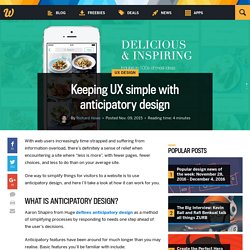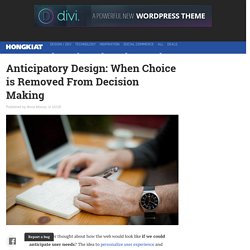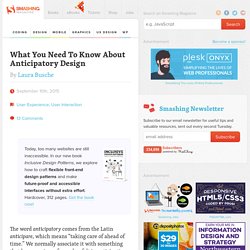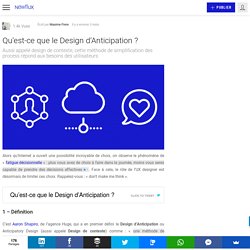

Keeping UX simple with anticipatory design. With web users increasingly time-strapped and suffering from information overload, there’s definitely a sense of relief when encountering a site where “less is more”, with fewer pages, fewer choices, and less to do than on your average site.

One way to simplify things for visitors to a website is to use anticipatory design, and here I’ll take a look at how it can work for you. What is anticipatory design? Aaron Shapiro from Huge defines anticipatory design as a method of simplifying processes by responding to needs one step ahead of the user’s decisions. Anticipatory features have been around for much longer than you may realise. Basic features you’ll be familiar with include: pop-up boxes;in-app notifications;recommendations;geolocation. All of the above boil down to users performing an action and being delivered a reaction to match it, with the aim of providing value, based on the users’ perceived preferences. Anticipatory Design: The Opportunities and Risks. Have you ever thought about how the web would look like if we could anticipate user needs?

The idea to personalize user experience and serve different content to different people based on their interests has lately appeared in the discussions about web design. The new approach is called anticipatory design, or sometimes context design, and takes experience design to the next level. It anticipates what customers need before the specific need even pops up in their mind, and customizes the content accordingly. When I heard about the new concept for the first time, I was fascinated, and eager to learn more about it, as it seemed to be an awesome idea. As I’ve read and thought more and more about it, I’ve begun to understand the concerns as well, and my initial enthusiasm has started to turn into skepticism.
Read more: Why Experience Design is the next big thing. UX Patterns of the Future: Anticipatory Design. Anticipatory design is a fairly new UX pattern that seeks to entirely remove user choice from the equation.

While this sounds creepy (and to be fair, it kind of is), decision fatigue is a real concern in UI design. In other words, anticipatory design opens up compelling possibilities by creating more personalized user flows. The Reality of Decision Fatigue I recently booked a cruise online, and it was in no way fun, easy, or simple—especially once I discovered the advertised rate was a lot less than I wound up paying. But let’s not get into details. The process was loaded with decisions. There’s a lot going on here: Hotel/flight packagesDestinationLength of tripDiscount optionsCruise linePreferred shipPort of departure Before I’ve even seen what I’m going to be enjoying, that’s a lot of decisions I’m expected to make right off the bat.
After the front page, it doesn’t get much easier. If this were an infomercial, right here would be the point where the audience screamed in unison: Nest Pandora. What You Need To Know About Anticipatory Design. Advertisement Today, too many websites are still inaccessible.

In our new book Inclusive Design Patterns, we explore how to craft flexible front-end design patterns and make future-proof and accessible interfaces without extra effort. Hardcover, 312 pages. Get the book now! The word anticipatory comes from the Latin anticipare, which means “taking care of ahead of time.” In a way, most products contain at least one element of anticipation. It’s Always Been Around Link Think about it: since the dawn of the web we’ve seen alert boxes, pop-ups, in-app notifications and many other components that are triggered to prevent something from happening in the future, or to invite you to make something else happen based on past behavior.
How to Get Anticipatory Design Right. Spotify predicts what songs you’ll like.

Amazon’s Dash Button reorders your favorite detergent when pressed. Nest anticipates your ideal room temperature. We’re entering a world of experiences designed to benefit users by making decisions on their behalf. Anticipatory design is the algorithm-powered, user-centric design discipline behind this world, and we’re already seeing products and services successfully leveraging machine learning to infer users’ preferences.
In the next stage of anticipatory design, products and services will aim to preempt every want and need. But anticipation will never be perfect, and the smartest algorithms will sometimes be wrong. At Huge, we created a framework so designers can determine if, when, and how an anticipatory service can improve their business. The probability of being right. The first half of the framework is made up of questions approaching anticipatory services from the user’s perspective. Aaronshapiro. Qu'est-ce que le Design d'Anticipation ? Alors qu’Internet a ouvert une possibilité incroyable de choix, on observe le phénomène de « fatigue décisionnelle » : plus vous avez de choix à faire dans la journée, moins vous serez capable de prendre des décisions effectives1.

Face à cela, le rôle de l’UX designer est désormais de limiter ces choix.